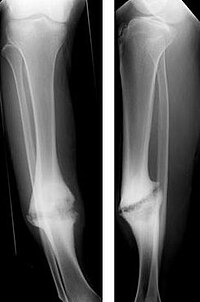
Photo from wikipedia
BACKGROUND Scaphoid non-union is often caused due to missed fractures, inadequate or inappropriate management. Matti-Russe and interpositional grafting techniques are used in the treatment of non-union. There are very few… Click to show full abstract
BACKGROUND Scaphoid non-union is often caused due to missed fractures, inadequate or inappropriate management. Matti-Russe and interpositional grafting techniques are used in the treatment of non-union. There are very few studies in literature that compare the outcomes of these techniques. The aim of our study was to analyse the factors influencing outcome in the management of scaphoid non-union and to compare the results of the Matti Russe procedure with interpositional grafting techniques. METHODS Fifty scaphoid non-unions with a mean follow-up of 39.9 ± 5.5 months were included in this retrospective study. Demographic parameters, treatment, functional and radiological outcomes were recorded. The influence of demographic and treatment factors on union in this cohort was statistically analysed. RESULTS Union was achieved in 76% of cases. Good to excellent results were achieved in 84% of patients. There was no significant difference in union rates, deformity correction achieved and period of immobilisation between the MR and IG techniques. The occurrence of arthritic changes correlated with the time interval between injury and surgery (p = 0.002). CONCLUSIONS The most important factor that influences the outcome is the time period between the occurrence of the fracture and surgery for non-union. The Matti-Russe procedure can achieve comparable results to interpositional grafting techniques with a shorter period of immobilisation than previously thought to be required. We believe that the presence of a deformity is not a contraindication for the procedure.
Journal Title: The journal of hand surgery Asian-Pacific volume
Year Published: 2017
Link to full text (if available)
Share on Social Media: Sign Up to like & get
recommendations!